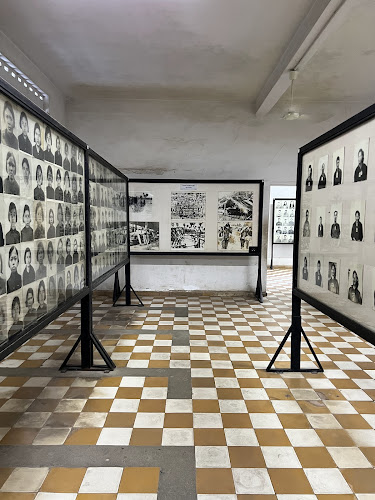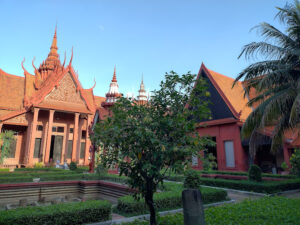
About Tuol Sleng Genocide Museum
Description
Walking through the gates of Tuol Sleng Genocide Museum is like stepping into one of humanity's darkest chapters. This former high school turned torture center, known as Security Prison 21 (S-21) during the Khmer Rouge regime, now stands as a powerful memorial to the estimated 20,000 prisoners who suffered within its walls. I've visited numerous historical sites across Southeast Asia, but few places leave such a profound impact on your soul as this one. The preserved classrooms-turned-cells, haunting photographs of victims, and original torture equipment create an atmosphere that's both educational and deeply moving. The museum does an exceptional job balancing historical documentation with respect for the victims. You'll find yourself walking quietly through corridors where rusted bed frames and implements of torture remain exactly as they were found in 1979.Key Features
• Original prison cells and torture rooms maintained in their found state • Comprehensive photo archives documenting prisoners and guards • Survivor testimonies and personal artifacts • Exhibition halls featuring historical documents and evidence • High-quality audio guide available in multiple languages • Educational displays explaining the rise and fall of the Khmer Rouge • Memorial room dedicated to victims • Original prison regulations and photographs on display • Regular guided tours with former survivors • Documentary screening roomBest Time to Visit
Early morning, right when the museum opens around 8:00 AM, is hands-down the best time to visit. The crowds are thinner, and the cooler temperatures make it easier to process the emotional weight of the experience. I'd recommend avoiding midday visits during peak season (November to February) when tour buses arrive in waves. The museum typically gets quieter again in late afternoon, but you'll want to give yourself at least 2-3 hours to fully absorb everything. Trust me, rushing through isn't doing justice to the significance of this place or its victims.How to Get There
Getting to Tuol Sleng is pretty straightforward. If you're staying in the central area of Phnom Penh, a tuk-tuk ride will take about 10-15 minutes, depending on traffic. Some drivers might know it better as S-21 rather than Tuol Sleng. You can also grab a PassApp (Cambodia's version of Uber) or arrange transportation through your hotel. If you're feeling adventurous, the museum is within walking distance from the Russian Market, though I'd recommend avoiding this option during the heat of the day.Tips for Visiting
Look, I'm gonna be straight with you - this isn't your typical tourist attraction. The experience can be emotionally overwhelming, and you'll need to prepare yourself mentally. Here are some tips I've learned from multiple visits: Definitely get the audio guide - it's worth every penny and provides crucial context you'd miss otherwise. Wear modest clothing out of respect (cover your shoulders and knees). The locals still consider this a memorial site. Take breaks when needed. There are benches in the courtyard where you can sit and process what you're seeing. Don't feel pressured to see everything if it becomes too intense. Photography is allowed in most areas, but please be respectful. This isn't the place for selfies or casual vacation photos. Some rooms specifically prohibit photos - honor these restrictions. Consider visiting the Killing Fields afterward rather than before. While both sites are important to understanding Cambodia's history, many visitors find it easier emotionally to visit Tuol Sleng first. Bring water and tissues. The buildings aren't air-conditioned, and the emotional impact of the exhibits often brings visitors to tears. There's a small cafe nearby if you need a break. If possible, time your visit to catch one of the survivor talks. These elderly survivors share their firsthand accounts of life in S-21, adding an invaluable human perspective to the historical exhibits. Remember that while this site documents unimaginable horror, it also stands as a testament to Cambodia's resilience and healing. The museum plays a crucial role in ensuring these events are never forgotten or repeated. I'd recommend setting aside some decompression time afterward - maybe a quiet meal or a walk in a nearby park. You'll likely want some time to process what you've seen before moving on to other activities. The experience might be heavy, but it's an essential stop for understanding Cambodia's recent history and the incredible strength of its people. Just approach it with respect, take your time, and don't hesitate to step outside if you need a moment to yourself.Description
Walking through the gates of Tuol Sleng Genocide Museum is like stepping into one of humanity’s darkest chapters. This former high school turned torture center, known as Security Prison 21 (S-21) during the Khmer Rouge regime, now stands as a powerful memorial to the estimated 20,000 prisoners who suffered within its walls. I’ve visited numerous historical sites across Southeast Asia, but few places leave such a profound impact on your soul as this one.
The preserved classrooms-turned-cells, haunting photographs of victims, and original torture equipment create an atmosphere that’s both educational and deeply moving. The museum does an exceptional job balancing historical documentation with respect for the victims. You’ll find yourself walking quietly through corridors where rusted bed frames and implements of torture remain exactly as they were found in 1979.
Key Features
• Original prison cells and torture rooms maintained in their found state
• Comprehensive photo archives documenting prisoners and guards
• Survivor testimonies and personal artifacts
• Exhibition halls featuring historical documents and evidence
• High-quality audio guide available in multiple languages
• Educational displays explaining the rise and fall of the Khmer Rouge
• Memorial room dedicated to victims
• Original prison regulations and photographs on display
• Regular guided tours with former survivors
• Documentary screening room
Best Time to Visit
Early morning, right when the museum opens around 8:00 AM, is hands-down the best time to visit. The crowds are thinner, and the cooler temperatures make it easier to process the emotional weight of the experience. I’d recommend avoiding midday visits during peak season (November to February) when tour buses arrive in waves.
The museum typically gets quieter again in late afternoon, but you’ll want to give yourself at least 2-3 hours to fully absorb everything. Trust me, rushing through isn’t doing justice to the significance of this place or its victims.
How to Get There
Getting to Tuol Sleng is pretty straightforward. If you’re staying in the central area of Phnom Penh, a tuk-tuk ride will take about 10-15 minutes, depending on traffic. Some drivers might know it better as S-21 rather than Tuol Sleng.
You can also grab a PassApp (Cambodia’s version of Uber) or arrange transportation through your hotel. If you’re feeling adventurous, the museum is within walking distance from the Russian Market, though I’d recommend avoiding this option during the heat of the day.
Tips for Visiting
Look, I’m gonna be straight with you – this isn’t your typical tourist attraction. The experience can be emotionally overwhelming, and you’ll need to prepare yourself mentally. Here are some tips I’ve learned from multiple visits:
Definitely get the audio guide – it’s worth every penny and provides crucial context you’d miss otherwise. Wear modest clothing out of respect (cover your shoulders and knees). The locals still consider this a memorial site.
Take breaks when needed. There are benches in the courtyard where you can sit and process what you’re seeing. Don’t feel pressured to see everything if it becomes too intense.
Photography is allowed in most areas, but please be respectful. This isn’t the place for selfies or casual vacation photos. Some rooms specifically prohibit photos – honor these restrictions.
Consider visiting the Killing Fields afterward rather than before. While both sites are important to understanding Cambodia’s history, many visitors find it easier emotionally to visit Tuol Sleng first.
Bring water and tissues. The buildings aren’t air-conditioned, and the emotional impact of the exhibits often brings visitors to tears. There’s a small cafe nearby if you need a break.
If possible, time your visit to catch one of the survivor talks. These elderly survivors share their firsthand accounts of life in S-21, adding an invaluable human perspective to the historical exhibits.
Remember that while this site documents unimaginable horror, it also stands as a testament to Cambodia’s resilience and healing. The museum plays a crucial role in ensuring these events are never forgotten or repeated.
I’d recommend setting aside some decompression time afterward – maybe a quiet meal or a walk in a nearby park. You’ll likely want some time to process what you’ve seen before moving on to other activities.
The experience might be heavy, but it’s an essential stop for understanding Cambodia’s recent history and the incredible strength of its people. Just approach it with respect, take your time, and don’t hesitate to step outside if you need a moment to yourself.
Location
Places to Stay Near Tuol Sleng Genocide Museum
Find Tours in Phnom Penh
Explore More Travel Guides
No reviews found! Be the first to review!


